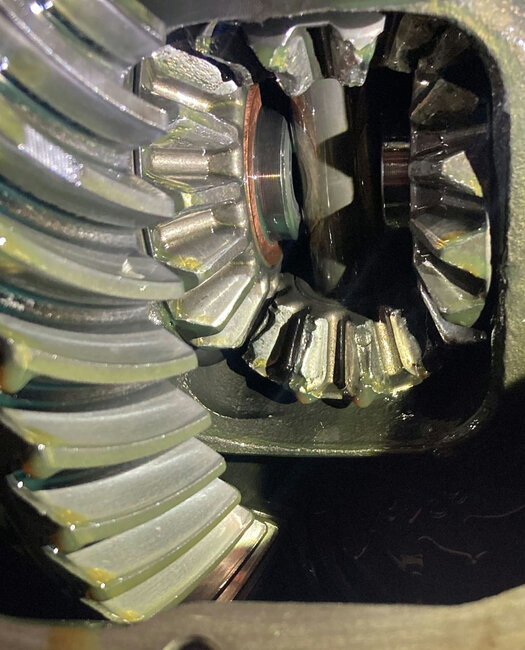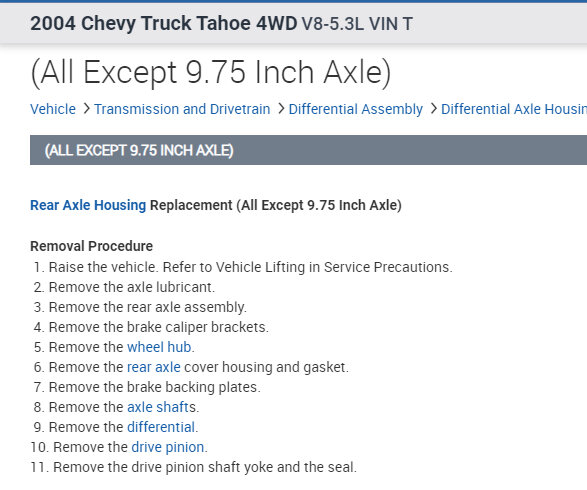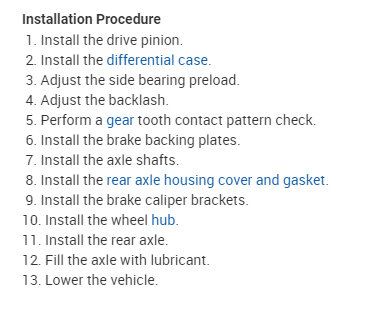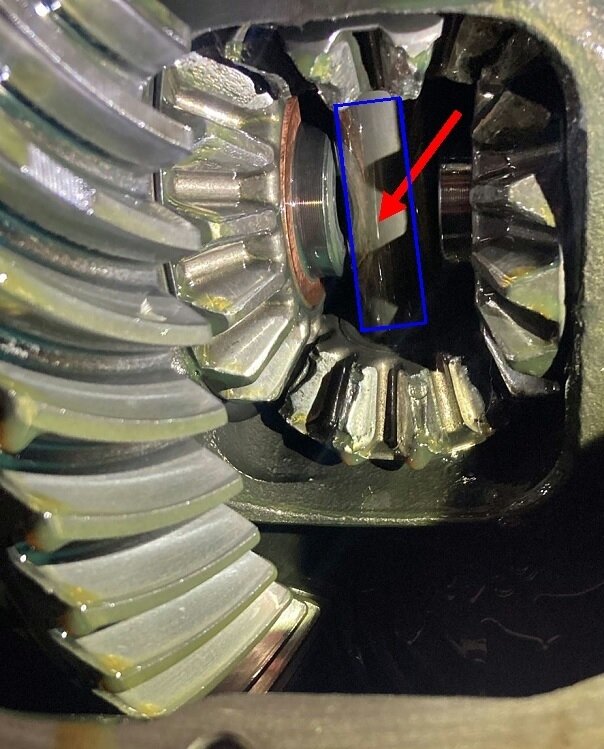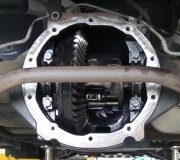I've never seen this before on any model, so if your research says this is common on this model, I would suggest it is a result of GM's habit of coming up with new designs and putting them into production for owners to test and find failures. It has been almost 20 years, so if this is a design issue, problems should have occurred a long time ago, (and we would have heard more about it).
Those four small gears actually see very little use so they rarely wear out. They are planted inside the carrier housing and basically sit still while that entire unit rotates as an assembly. That's why they do not make noise. The only time those gears move is when you go around any type of corner, or when one tire is slightly smaller than the other one. The two wheels have to be rotating at different speeds. The biggest stress they will encounter is when one wheel is spinning when that tire is on ice or mud, then that tire suddenly gets traction and makes the other wheel want to spin.
That is also the time you will hear rumbling from those gears. To observe that, raise the rear tires off the ground and support the truck on jack stands. Run the engine, in gear, and most of the time both rear wheels will spin together, at the same speed. Now hit the brakes, then block one wheel with something like a 2 x 4 or cement block. Be careful if you use a long 2 x 4 with the tire still spinning as it can catch the board and shout it out unexpectedly. I hold it up at a high angle and press it against the tire until it stops spinning, then I push the board under the tire to hold it from starting up again.
Now, if this is an "open" differential, with the rear driveshaft spinning at the same speed as before, the blocked tire will be standing still and the other one will be spinning twice as fast as before. Now is when those axle and spider gears are running the fastest they ever will, and this is when you'll hear any noise they might cause. I suspect you're going to hear a lot of crunching or growling.
If this was due to abuse, another place to look is where the pinion shaft goes through the housing. In your dandy photo, I highlighted it with a blue box, and my red arrow is pointing to it. Rotate the driveshaft roughly half a revolution and this window will move away, then you'll see the hole where the shaft goes through. It's roughly one inch in diameter. On highly abused differentials, especially those on older muscle cars with manual transmissions, that hole gets hammered out into a big oval. That lets the shaft walk back and forth. You won't usually notice anything while driving, but if you put it in "park" on an incline, or in gear if it's a manual transmission, the vehicle is able to coast a good four to eight inches before stopping. That's due to that shaft being able to move around while the driveshaft is held in place. There's no fix for that other than to replace the center section. There's also a small bolt with a 5/16" head holding that shaft in place. To be able to walk back and forth in the oval-shaped holes, that pin has to be sheared off. It's only a matter of time before the shaft slides out and catches on the housing. That can result in an exploded housing or a broken transmission housing.
If those two holes are okay, repairs are likely going to be rather straight forward and somewhat easy for a competent do-it-yourselfer. It's the larger ring gear and the pinion gear driven by the driveshaft that are extremely critical. There are some serious adjustments that move those gears in various directions to prevent noise and promote proper wear patterns. Best is to leave that alone as we never set them up as well as how they came from the manufacturer of the assembly. Those four smaller gears are a different story. As I mentioned, they only rotate when the two wheels are turning at different speeds, and they turn way too slowly to make noise. There are no spacing adjustments because it isn't necessary.
Remove that small bolt with the 5/16" head. Use a small 1/4" ratchet or a small box wrench, and don't use a lot of force. You can create more misery if that bolt snaps off. The only threads on it are right under the head, for less than a half inch, then the rest is just a straight, smooth pin, about 1/4" in diameter. If excessive hammering has led to the 1" pin moving a little, that will deform the smaller bolt and start to shear it off. It also makes it want to not turn freely. If you encounter that, work it back and forth while slowly turning it out a little more each time.
Once that pin is removed, rotate the driveshaft until that 1" pin can be pushed out. Finger pressure should do it. Often they slide out from gravity and unexpectedly land on our feet. With that shaft out, grab either rear tire and rotate it by hand. As you do that, the top and bottom spider gears will walk toward or away from the opening. When they go far enough, you can lift the top one off and pull the bottom one out. You'll have to turn the tire both ways. One way brings the top gear toward you, then spinning the tire the other way walks the bottom gear toward you. If those are the only two you're going to replace, that is as far as you need to go. Note there's a stamped steel plate on the back of each gear. They form a wear surface and should be reinstalled with the replacement gears. Installing them can get a little tedious because you have to start each one at the same time so as you rotate the tire again, they'll be drawn in and reach the holes in the housing at the same time. If you accomplish that on the first try, you're much better than the rest of us. A better bet is you're going to be off by a couple of teeth the first time, and it will take a half dozen attempts before they're both in position at the same time so the shaft can be slid back in.
If you need to replace the two axle gears too, that is done as soon as those two spider gears are walked out. Rotate the driveshaft again to put the carrier in the same orientation as it is in your photo. With the pinion shaft out, grab one rear tire / wheel and push it in toward the truck. It will go about a quarter inch. Back in the differential, you'll see the axle shaft has moved through its gear, and a large C-clip is exposed. It had been sitting in a pocket in the middle of the gear. Sometimes we get lucky and it falls off from gravity. When gravity isn't strong enough, you'll need to spin it around and sometimes fight with it to get it to slide off. If you don't see that C-clip, it's possible the gear stuck to the axle shaft and moved in with it. Just push the gear back with your finger, then you'll see that C-clip.
If you have to, you can pull the wheel / tire / axle shaft out a little to make room to slide the axle gear off the axle shaft. I should mention too, this works when you have rear drum brakes. A lot of trucks today have rear disc brakes. Typically we aren't strong enough to push the wheel and tire in to remove the C-clip because the caliper slides too hard. In that case, you'll have to take extra time to remove the wheel / tire, and then the caliper, so the brake rotor and axle shaft can be pushed in. Slide the replacement gear onto the axle shaft, then slide the C-clip back on It will likely spin around and fall off at least three times. Swear words usually don't help. Once that C-clip is on the shaft, if the wheel has been removed, you can push the shaft out with your finger from inside the differential housing. Doing so locks the C-clip in place so it can't fall out.
Do the same thing on the other side. As a side note, these are the same steps we take when replacing a leaking grease seal on the ends of the axle housing. If you want to pursue that, you need to slide the axle shaft out. That can be a messy job, so be prepared with rags and perhaps some cardboard on the floor to catch the few drops of gear lube.
From this point, continue with installing the two spider gears. Once the pinion shaft is back in place, all four gears are held in place. If I had a choice, I'd elect to install a new retainer bolt, but we rarely have one at hand when we're trying to finish up a job.
Because these four gears don't spin fast enough to make noise, and because they see so little wear, I would feel comfortable harvesting replacements at a salvage yard. There are three different axles listed for your truck. Replacing these gears is on the most common axle that has been used since forever by the big three manufacturers. The larger axle has eight bolts at the end of the housing, right in the middle of the center hole for the wheel. With that style, once the eight bolts are removed, you can slide the axle shaft out without removing the wheel / tire, and without even removing the differential cover. If you have that style, I'll have to format the procedure and post the steps for you. Also, if you have a locking differential, there will be a stack of clutch plates between the two axle gears. Special tools are needed to take that one apart, but I can post the instructions too.
Let me know if I missed anything or if you have questions.
Image (Click to make bigger)
Saturday, November 4th, 2023 AT 11:09 PM
